German Shepherds originated in Germany and were bred to herd sheep. They are now ranked as the 2nd most popular dog in the US and 8th in the UK.
The Swiss Shepherd, also known as the White Swiss Shepherd and the Berger Blanc Suisse, is a stunning-looking dog, similar to the German Shepherd. So, what’s the difference between a German Shepherd and a Swiss Shepherd?
The difference between the German Shepherd and the Swiss Shepherd is in their color, as the Swiss Shepherd only has a white coat, whereas the GSD comes in various colors. Both breeds appear almost identical other than coat color. However, they also have slightly different temperaments.
Another key difference is the origin. We know the GSD came from Germany, but what about the Berger Blanc Suisse?
The Swiss Shepherd was initially developed from the white-coat line of the German Shepherd Dog, which was bred in Switzerland after being imported from America.
The breed is the less popular of the two. Still, it is becoming more sought after since becoming a recognized breed of its own by the Fédération Cynologique Internationale (World Canine Organization) in 2011 and the UK Kennel Club in 2017.
This article will examine the German and White Swiss Shepherd’s main traits and their comparisons. We will learn about each breed’s history and highlight their similarities and differences.
I aim to provide you with all the information you need if you are contemplating buying or adopting a German Shepherd or a White Swiss Shepherd. Both are genuinely fantastic breeds.
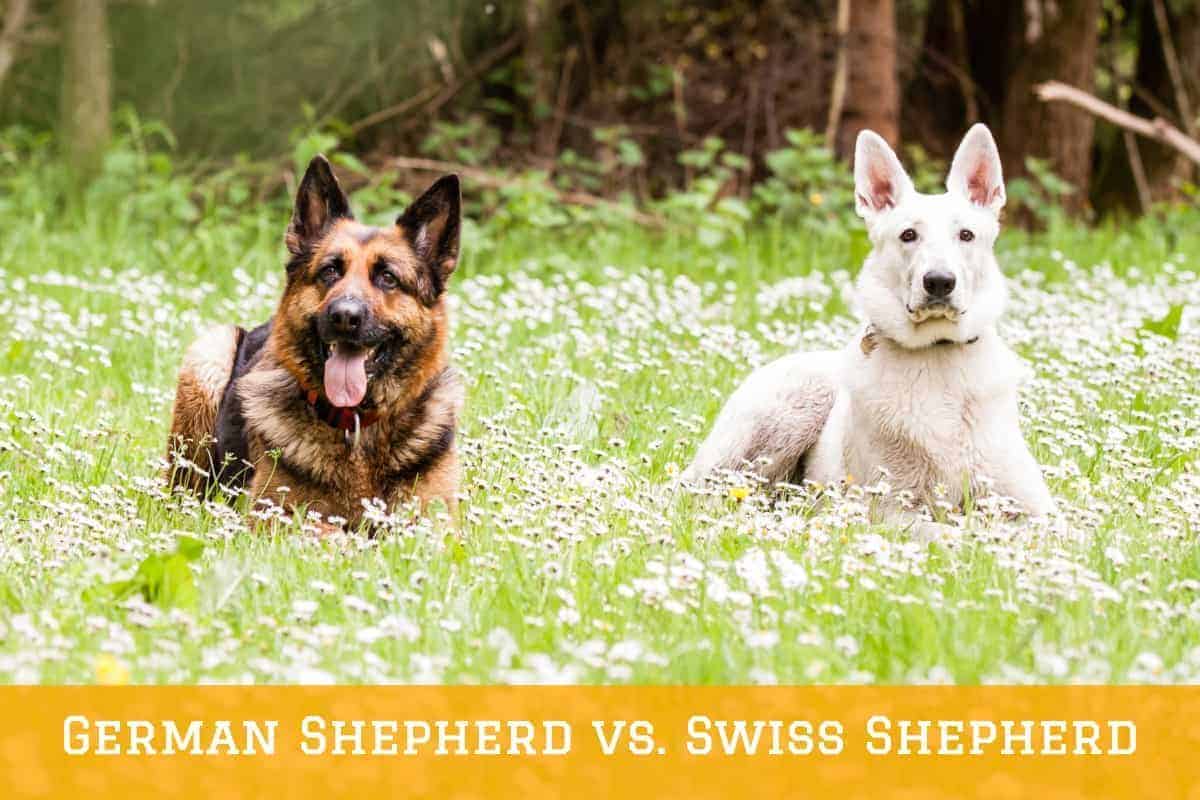
Difference Between German Shepherds and Swiss Shepherds
It is a common question if you want to bring either of these breeds into your home – what is the difference between a German Shepherd and a Swiss Shepherd? There is no doubt both breeds are great family dogs.
There are several similarities and differences between these two breeds. Choosing a German Shepherd or a White Swiss Shepherd will ultimately depend on what you seek in a dog.
You should probably choose the German Shepherd if you seek an easily trainable, reliable working dog.
This breed is intelligent, brave, loyal, and protective, but it can be aggressive toward intruders if not trained. Due to their protective nature, GSDs are considered excellent police and guard dogs.
However, if you are looking for a more gentle and calmer family dog with a lovely temperament, you should choose the White Swiss Shepherd.
This breed is considered more mellow and is excellent with children. They rarely become aggressive unless mistreated.
Although they are utilized as family companion dogs, they are also easy to train and do well as a service or therapy dog or search and rescue.
This excellent video highlights the main differences between the white-coated German Shepherd and the Swiss Shepherd. I must mention that the white GSD is purebred and no different from any German Shepherd, other than coat color.
Below, we will explore the differences and comparisons between these two fantastic breeds of dogs.
German Shepherd vs. Swiss Shepherd
So, what sets these two breeds apart?
Below is a table highlighting the main differences between both breeds. I took each dog’s height and weight statistics from the FCI Breed Standard. Of note is that the American Kennel Club (AKC) and the UK Kennel Club classify the German Shepherd as a large breed dog.
Also, please note that heights and weights are always a guide, and a dog might be larger or smaller (weight or height) than the sizes stated in the Breed Standard.
Differences Between German Shepherds and Swiss Shepherds
| GERMAN SHEPHERD | SWISS SHEPHERD | |
|---|---|---|
| GROUP | Herding dogs | Herding dogs |
| ORIGIN | Germany | Switzerland |
| MALE HEIGHT | 60 – 65 cm 24 – 26 inches | 58 – 66 cm 23 – 26 inches |
| FEMALE HEIGHT | 55 – 60 cm 22 – 24 inches | 53 – 61 cm 21 – 24 inches |
| MALE WEIGHT | 30 – 40 kg 66 – 88 pounds | 30 – 40 kg 66 – 88 pounds |
| FEMALE WEIGHT | 22 – 32 kg 49 – 71 pounds | 25 – 35 kg 55 – 77 pounds |
| APPEARANCE | Any pigmentation (nose can be black or pink) | Dark pigmentation (e.g., black nose, paw pads, lips) |
| HIP ANGULATION | More severe angulation | Less severe angulation, More upright stance |
| LIFESPAN | 10 – 13 years | 12 years |
| LITTER SIZE | 8 | 6 – 8 |
| DOG SIZE (FCI) | Medium | Medium |
| OTHER NAMES | Alsatian, Alsatian Wolf Dog, Schäferhund, Deutscher Schäferhund | Berger Blanc Suisse, White Swiss Shepherd Dog, Snowy Shepherd, Polar Bear Shepherd |
| COAT COLORS | Black and Tan, Bicolor, Black, Black and Red, White or Cream, Sable | White only |
| COAT TYPE | Double-coated, short to medium, medium, or long | Double-coated. Varies from medium to long |
| SHEDDING | Heavy, Constant, seasonal | Heavy, constant, seasonal |
| TEMPERAMENT | Outgoing, Brave, Protective, Watchdog, Strong, Confident, Intelligent, Alert, Independent, Loyal, High-energy, Aloof, Affectionate, Versatile | Balanced Personality, Affectionate, Territorial, Social, Alert, Courageous, Playful, Energetic, Friendly, Gentle, Loyal, Sensitive, Intelligent, Independent, Versatile |
| GROOMING | Moderate maintenance | Moderate maintenance but can be high if live in a rainy climate, such as the UK |
| TRAINABILITY | Easily trainable | Easily trainable |
| HYPOALLERGENIC | Not hypoallergenic | Not hypoallergenic |
| CHILD FRIENDLY | Yes | Yes, very child friendly |
| NEW OWNER FRIENDLY | Yes | Yes, very good first dog |
| COST | $900 – $4,500 | $3,000 – $5,000 |
As you can see from the above table, these two breeds have many differences and similarities. We will now look at the main differences between the German Shepherd and the White Swiss Shepherd, including history, personality, nutrition, and health issues.
History, Temperament, Nutrition & Health Issues
German Shepherds are generally considered to be all-purpose working dogs. They have medium-large builds and are agile, muscular, strong, highly intelligent, and versatile. The GSD is fun, loyal, confident, and courageous – making them the perfect match for many dog lovers.
Swiss Shepherds appear almost identical to the white German Shepherd, with the typical Shepherd face and pointy ears. However, they have less severe hip angulation and a more upright stance.
They also have quite a different temperament: they are less aggressive than the GSD and have a calmer demeanor. They were explicitly bred with a lower drive and are less intense – making them a good family pet.
Although still protective, they are more friendly and gentle and are particularly good with children.
The Swiss Shepherd retains its working abilities from the founding breed, the German Shepherd. However, they make better all-purpose farm dogs due to their lower drive. Check out our video below:
The History of the German Shepherd
True to their name, German Shepherds originated in Germany during the late 1800s. Due to being incredibly intelligent, strong, responsive, and obedient, German Shepherds were bred to be working dogs responsible for herding sheep and protecting flocks.
They were not initially considered household pets or companions. Instead, they were specifically bred to work as all-purpose farm dogs and herders. Their sense of smell, intelligence, courage, and speed made them perfect shepherds.
By the start of World War 1, the German Shepherd breed had become incredibly popular throughout Germany and had already started spreading to other parts of the world.
The breed became popular in the UK and America, partly due to the popularity of dog movie stars Strongheart and Rin-Tin-Tin and partly from returning soldiers of the First World War who spoke very highly of the breed.
People loved the German Shepherd’s characteristics, especially their loyal and courageous demeanor.
These outstanding qualities have made the German Shepherd an increasingly popular dog breed. Nowadays, German Shepherds rarely herd sheep but are often used as police and military dogs, dogs for the blind, and search and rescue.
Learn More About The German Shepherd In This Video…
The History of the White Swiss Shepherd
The White Swiss Shepherd is a relatively new breed, but they share the same ancestry as a German Shepherd. Historically, white-coated German Shepherds were considered highly valued because they were distinguished easily from wolves in the fields.
This is where it gets interesting! From the first German Shepherds, all colors, including white, were accepted. The white variant is due to a recessive gene and is not an albino, as often thought.
Nevertheless, in 1933 during the Nazi regime, white coats became undesirable in the breed standard of the German Shepherd Dog Club of Germany. The white GSD began to be excluded in Europe.
An effort to preserve the white-coated German Shepherd led to the first White Shepherd Club founded in 1964 in the US. The white-colored German Shepherd was renamed the White Shepherd, and they have gradually become accepted as a distinct breed in the USA and Canada.
The Swiss Shepherd was developed from the white-coat line of German Shepherds after a male White Shepherd was taken to Switzerland in 1967 and bred with other imported White Shepherds, mainly from the United States, Canada, and England.
These were considered to be the foundation dogs of the White Swiss Shepherd Dog.
Although it shares the same lines as the white German Shepherd and the White Shepherd, the Swiss Shepherd was officially recognized as a breed in Switzerland in 1991.
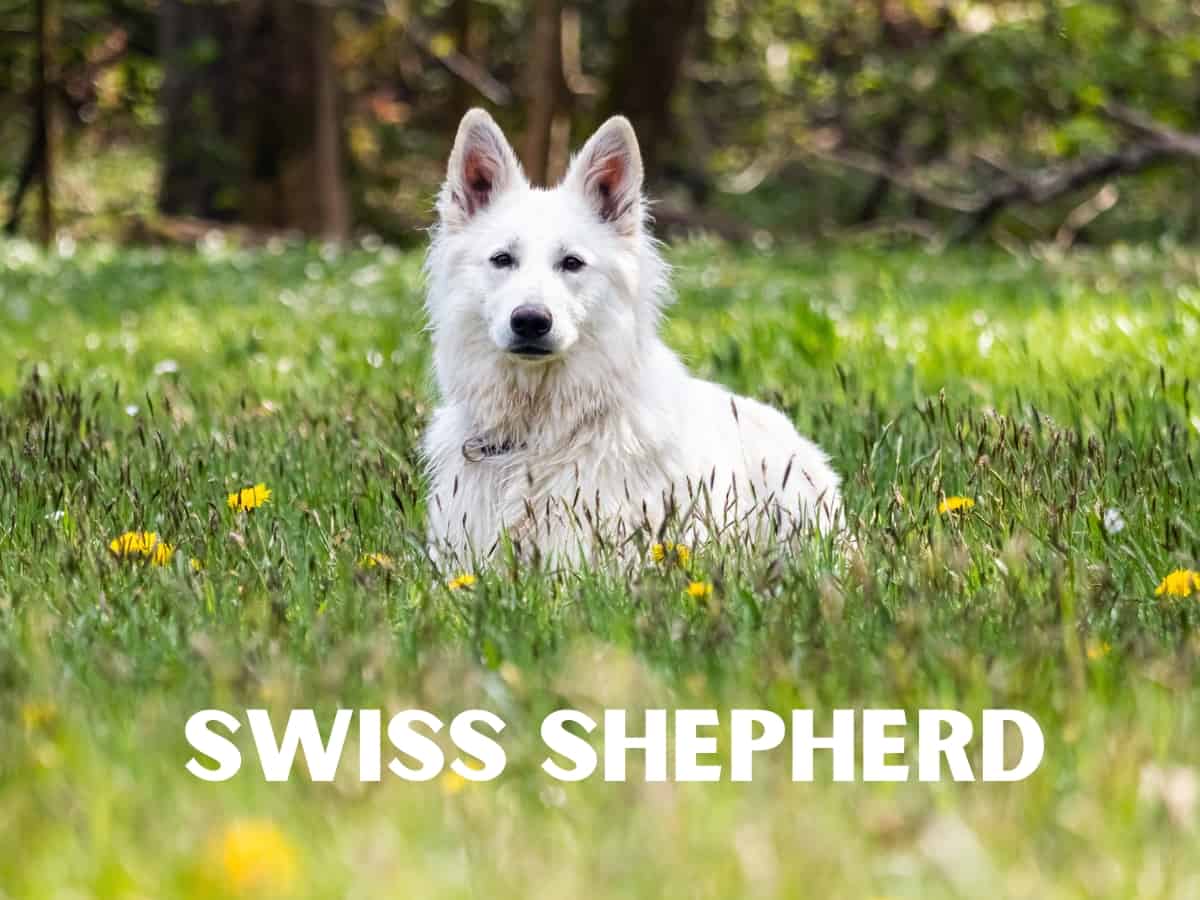
Despite being around for many years, it was not until 2011 that the White Swiss Shepherd was considered an official breed by the FCI (Federation Cynologique Internationale). In addition to this, the UK Kennel Club has only recognized the breed since 2017.
The breed remains unrecognized by the American Kennel Club (AKC) and the Canadian Kennel Club, but hopefully, they will soon accept this beautiful dog.
It can be a bit confusing – but technically speaking, the Swiss Shepherd, White Shepherd, and white German Shepherd are now all different breeds with different breed standards:
- The Swiss Shepherd is recognized by the FCI (World Canine Organization).
- The white German Shepherd is recognized by the AKC (although it is disqualified from showing) and the UK Kennel Club.
- The United Kennel Club recognizes the White Shepherd.
German Shepherd Behavior and Temperament
German Shepherds are very eager to please, making them easy to train. Obedience training at a young age will help to ensure that a German Shepherd puppy grows up to become a well-trained adult. However, GSDs are one smart cookie, and you can train them regardless of age.
German Shepherds make excellent protective companions or watchdogs, and they love having a job to do. They form an intense bond with their owners from a young age, and due to this, some can become quite clingy and suffer from separation anxiety if left alone for long periods.
Most pet GSDs have a low prey drive and can be appreciated for their companionship with humans.
The German Shepherd can become quite nervous and occasionally aggressive when faced with strangers. This is because they are very loyal to their family, which stems from their natural guarding instincts.
If not raised in a loving home, socialized, and trained, German Shepherds can quickly grow up to become aggressive.
The GSD is a very active dog that requires lots of daily exercise. It needs at least two hours of physical activity every day, such as walks, hikes, off-leash running, frisbee, fetch, or agility, and these should be done in two separate sessions.
German Shepherds are known to get into mischief without regular exercise and display destructive behavior such as digging, chewing, barking, or howling.
They love to be part of the family and don’t do well if left outside or alone for long periods.
Some will say that German Shepherds need acres and acres to live happily. However, this is not entirely true. Having a decent-sized yard might be beneficial, but as long as they are exercised and cared for properly, they can adapt to living in smaller spaces, even apartments.
Please be aware that this will require lots of extra work, so ensure you have a suitable lifestyle and devote time to your dog.
Swiss Shepherd Behavior and Temperament
The White Swiss Shepherd is a good family dog. They are smart and loyal dogs with happy personalities.
They are sociable and eager to learn and make terrific family dogs and working companions. The average White Swiss Shepherd is inquisitive, watchful, and good with youngsters.
The Swiss Shepherd is known for its kind and loving nature, being more gentle and less aggressive. They were specifically bred to be less intense with a lower working drive.
This impressive breed retains its working abilities but is better suited as an all-purpose farm dog (if working) or makes an ideal companion pet.
They are also very loyal and protective dogs, especially towards children. This breed is affectionate and sensitive to how they are treated and thrives off praise when they have done something to please you.
White Swiss Shepherds are highly intelligent and enjoy learning new tricks and commands. They train easily and excel as service or therapy dogs but are not utilized in the police or military due to their calmer demeanor.
Their excellent temperament makes them ideal family pets who will be kind and friendly to children.
Like the German Shepherd, White Swiss Shepherds tend to be quite clingy towards their owners, and they can seem timid. This can be both a good and a bad thing.
They display intense bonding towards their owner but can also develop separation anxiety when left alone for too long. This can lead to destructive behaviors such as barking, chewing, or digging.
White Swiss Shepherds are an active breed, and due to their strong herding tendencies, they require a great deal of daily exercise, including running and playing.
Again, if they are left without exercise, they can become destructive as they need to release the buildup of energy within them. They enjoy dog sports, which also keep them mentally and physically stimulated.
German Shepherd Nutrition and Health Issues

The German Shepherd breed is generally a very fit and healthy dog with an average lifespan of around 10-13 years.
However, like many other pedigree breeds, some hereditary conditions can cause problems in the German Shepherd. Due to this, it’s essential to choose a reputable breeder.
Responsible breeders usually screen their breeding stock for hereditary health conditions, such as degenerative myelopathy (DM) or hip dysplasia.
The GSD needs high-quality food to provide all the nutrition he needs for an active lifestyle. There are many different types of diets to feed your dog, such as dry, wet, raw, etc.
German Shepherds can also be prone to experiencing bloat. This condition causes swelling of the abdomen, which can occur very suddenly and can be potentially life-threatening.
With this in mind, German Shepherd owners should educate themselves on the symptoms to look out for.
Swiss Shepherd Nutrition and Health Issues
We have learned that the White Swiss Shepherd also has a great deal of energy. With this in mind, feeding a Swiss Shepherd healthy, high-quality dog food formulated for active breeds is also important. This ensures that the dog’s energy needs are met.
This beautiful breed is also considered to be a very healthy dog. However, it is no surprise that the Swiss Shepherd shares the same hereditary conditions as their close cousin, the German Shepherd, such as hip and elbow dysplasia. The Swiss Shepherd is also prone to bloat and can suffer from a sensitive stomach.
The White Swiss Shepherd Club of America states the Swiss Shepherd has a lifespan of around 12 years.
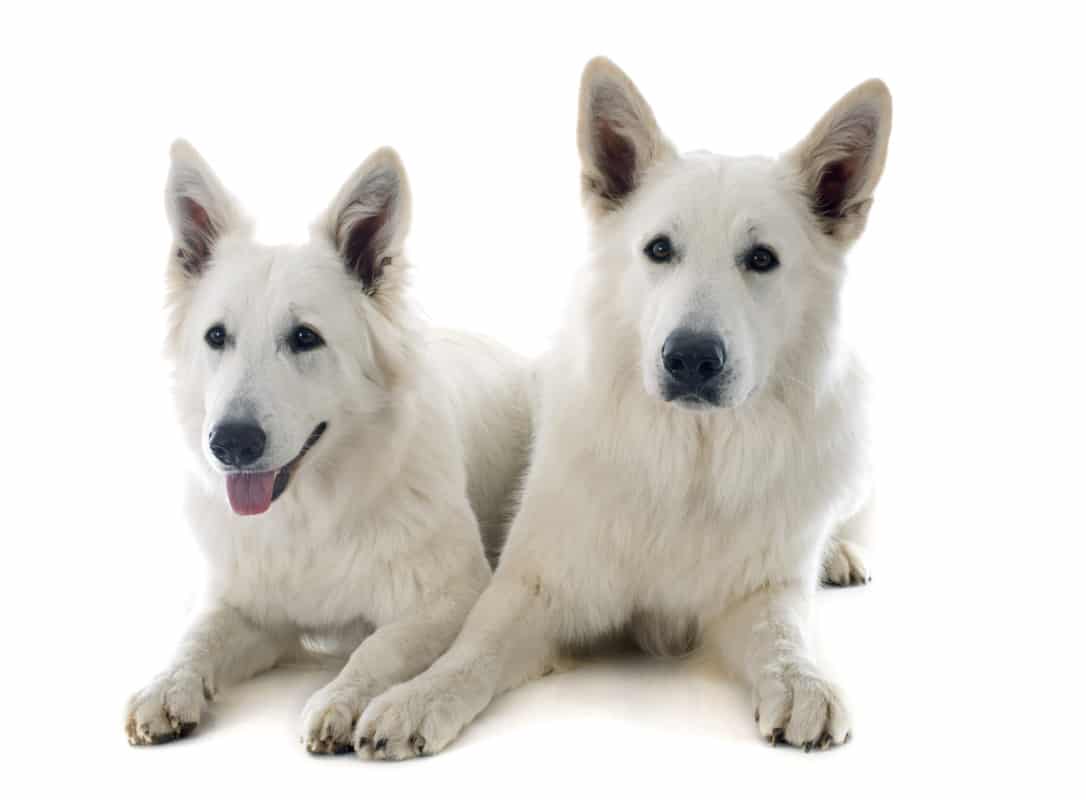
What Else To Know About Swiss Shepherds
The White Swiss Shepherd has many striking features: its bright white coat, beautiful expression, and wolf-like appearance. It is becoming an increasingly popular breed worldwide due to its impressive beauty and desired personality.
The Swiss Shepherd is more expensive to purchase than the GSD. Depending on lineage, breeder reputation, location, litter size, and demand, prices can vary.
The price is around $3,000 for an average pup without breeding rights or show quality. Expect to pay up to $5,000 for top breed lines.
In contrast, expect to pay around $2,000 for an average German Shepherd. However, this price can quickly grow to $4,500 or even more for top breed lines, such as a show or working dog.
Origins
As its name suggests, the Swiss Shepherd originated in Switzerland, whereas the German Shepherd was originally developed in Germany. The White Swiss Shepherd emerged from the white lines of the German Shepherd Dog.
Appearance
The main obvious difference between the German Shepherd and the Swiss Shepherd is in their appearance. While the German Shepherd comes in several colors – the coat is usually dark, consisting of either tan and black, red and black, sable, or all black or all white.
In contrast, the Swiss Shepherd has a completely bright white coat.
The White Swiss Shepherd is classed as a medium-sized dog by the FCI. The dog’s stance is more upright and less severe at the hips, with a level and firm back, whereas the German Shepherd is much more angular at the hips, with a slightly sloping back.
Here are the FCI’s full breed standards for the White Swiss Shepherd and the German Shepherd.
Similarities Between Both Breeds
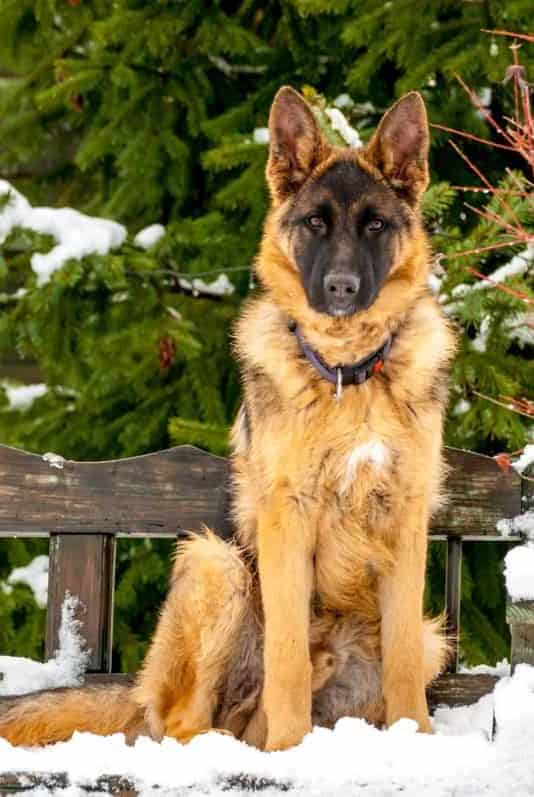
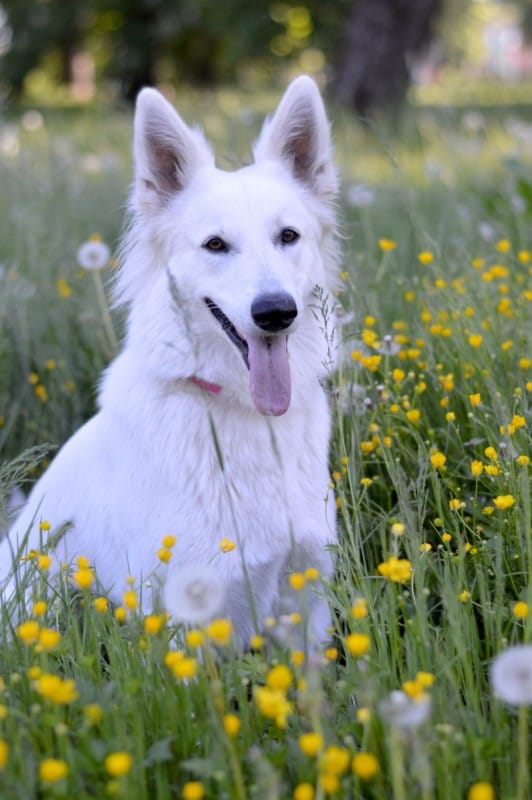
As you can see, there are several differences between the German Shepherd and the Swiss Shepherd. However, they also share many similarities! Below are the main similarities between the German Shepherd and the Swiss Shepherd.
Ancestry
The German Shepherd and the Swiss Shepherd share the same ancestry. The Swiss Shepherd is very closely related to the beautiful white variation of the German Shepherd.
In 1967, Miss Agatha Burch took a male White Shepherd named “Lobo White Burch” from the US back to Switzerland after living in the US for many years. She then imported a female white German Shepherd from the UK, named “White Lilac of Blinkbonny,” and bred the two.
These two dogs and a few other Canadian imports became the foundation of the modern White Swiss Shepherd Dogs.
Intelligence
Both of these breeds are incredibly intelligent and easy to train. They can learn many skills and tricks and respond well to commands. When socialized and trained well, the Swiss Shepherd and German Shepherd are highly disciplined and respected. It is for these reasons they are used as working dogs.
Loyalty
The German Shepherd and the White Swiss Shepherd are loyal, devoted, protective, and eager to please their owners. While Swiss Shepherds can be slightly needier towards their owner due to their gentleness, both will protect their family and territory due to their herding genetic traits and bloodlines.
Good with Children and Other Pets
When brought up around children or other pets, the Swiss Shepherd and German Shepherd are very good with them, the former being slightly better due to their friendliness.
Looking for the right dog breed to bring into the family can be daunting. However, both are great choices and bringing a German Shepherd or White Swiss Shepherd puppy into your family will be a success.
Which Breed Would Make the Perfect Pet?
The answer to this question really lies in what you are looking for in a pet and your particular circumstances and lifestyle.
If you are looking for a loyal, protective, confident watchdog, I recommend a German Shepherd. Due to his more aggressive nature, he makes the perfect guard dog while remaining devoted and true to his owner. Perhaps they can also do good police work or be service dogs.
Even though they are affectionate and loving dogs, they remain incredibly protective of their owners and territory.
However, if you want a less intense loving family pet with a lower drive, I would definitely recommend the Swiss Shepherd. Being aggressive does not tend to be in their nature, and they have a gentler and calmer demeanor.
Please note that both require the same daily exercise and thrive from being well-trained and worked.
This is an essential factor to remember when considering a German Shepherd or a Swiss Shepherd as a pet, as you must devote lots of time to ensure their daily needs are met.
FAQs
Do German Shepherds and White Swiss Shepherds Have Different Coat Types?
Yes, German Shepherds and Swiss Shepherds do have different coat types. German Shepherds have a double coat with a thick, dense undercoat and a longer, coarser topcoat, while Swiss Shepherds have a shorter coat that is either straight or slightly wavy. The coat colors and patterns can also differ between the two breeds.
Which Breed Is Better for Families or Certain Types of Owners?
German Shepherds may be better suited for families with active lifestyles and experience with training and socializing dogs, while Swiss Shepherds may be a better fit for families who want a more laid-back dog that is still protective and affectionate.
Can Swiss Shepherds Be Black?
Swiss Shepherds cannot be black or any other color, hence their name, White Swiss Shepherds. This is in contrast to their ancestors, the German Shepherds, which come in a range of colors from the classic black and tan, black and red, to sable, all black, all white, and bi-color, among others.
Final Thoughts
There are many similarities and differences between these two fantastic breeds of dogs. Here are some key takeaways from the article:
- The main differences between the German Shepherd and the White Swiss Shepherd are their coat color, country of origin, temperament, and popularity.
- The Swiss Shepherd is always white in color.
- Both breeds make wonderful and very loyal pets.
- The German Shepherd and the Swiss Shepherd have almost identical traits; however, the Swiss Shepherd is less intense, calmer, and less aggressive.
- They are both great as working dogs due to their intelligence and easy trainability.
I hope this article has helped you understand the difference between the German Shepherd and the White Swiss Shepherd, as it can initially be somewhat confusing. If you plan on buying or adopting either one for a pet, you now have all the information to help you decide. Good luck!
Related Posts You May Like:





